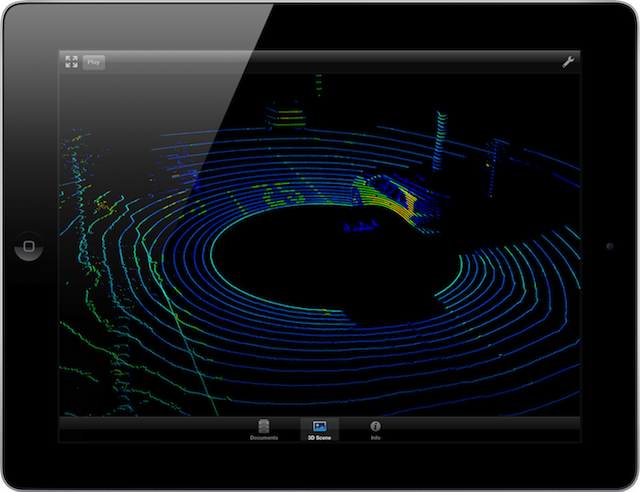Velodyne debuts VeloView
Velodyne has introduced new open source software called VeloView for real-time visualizing and processing of 3D data from its high-definition lidar (HDL) sensors.
Morgan Hill, Calif.-based Velodyne’s lidar division manufactures and sells the HDL-64E and HDL-32E sensors for use in commercial autonomous vehicle, security/surveillance, and 3D mobile mapping applications.
VeloView displays distance measurements from the lidar sensors as a point cloud and supports custom color maps of variables such as intensity-of-return, time, distance, calibrated reflectivities, azimuth, and laser id. The point cloud can be exported as XYZ data in CSV format, and screenshots of the displayed point cloud can be exported by touching a button, the company said.
3D data acquired over a period of time can be viewed in playback mode at regular, increased or decreased speeds, which is especially useful for applications like autonomous driving, security, and surveillance, where objects move relative to the sensor over time and the playback mode allows users to display changes in the environment as a function of time, Velodyne said.
VeloView can playback pre-recorded data stored in .pcap files. The HDL sensors sweep their lasers (32 or 64) 360º and a vertical field of view of 40º/26º with 5-20Hz and captures about a million points per second (HDL-32E: ~700,000pt/sec; HDL-64E: ~1.3Million pt/sec).
Velodyne’s big interest in open source
The software is built on open source app developer Kitware Inc.’s ParaView technology and underlying Visualization Toolkit (VTK).
Links to the source code, along with Velodyne sample data, can be found here.
Executable versions of VeloView for Windows and Mac OS can be downloaded from the “Community Contributed Applications” area at no charge.
Former Velodyne Lidar Executive Vice President Stuart Woods – now vice president for Leica Geosystems’ Geospatial division – told SPAR last year of his big interest in bringing 3D data capture to the open source movement, and even telegraphed VeloView’s open source origins.
“It’s our intention to release our viewer as an open source product, and launch a wiki environment and make that available to users,” he said. “We’ll also be making available some packet streamers that allow you to interact with other viewers.”
The open source movement is important, Woods said, because “as we start to look at how we can collectively grow the 3D market, the concept of engaging and supporting open source is certainly a way to enable new applications that I can’t even think of right now, and I would encourage my competitors as well to think about how they can help that process … We need to help innovators come up with those new ideas.”






